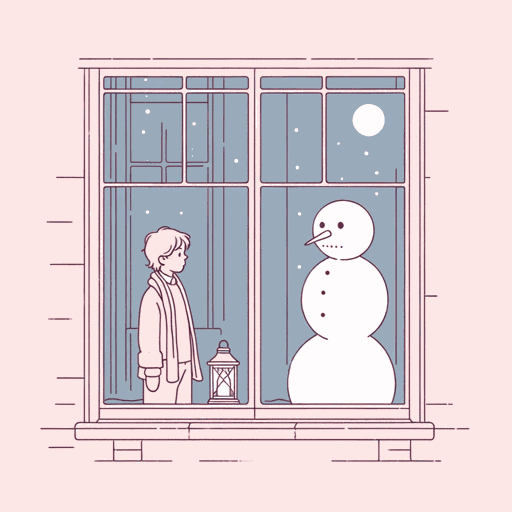17 pages • 34 minutes read
Richard WilburBoy at the Window
Fiction | Poem | Adult | Published in 1952A modern alternative to SparkNotes and CliffsNotes, SuperSummary offers high-quality Study Guides with detailed chapter summaries and analysis of major themes, characters, and more.
Summary and Study Guide
Overview
Reflecting his career-long fascination with the revelations of everyday moments, Richard Wilbur’s “Boy at the Window,” is a poignant narrative of a young boy fretting over the perils his backyard snowman will face as the bitter winter night approaches. It lovingly illuminates the anxieties of childhood and the difficult trick of empathy. First published in the January 5, 1952 New Yorker to a world eye-deep in winter, the poem juxtaposes the sweet if hyperbolic fears of the boy against the wiser and more balanced wisdom of the snowman who understands that being out in the winter night is exactly where he needs to be.
By the time of the poem’s publication, Wilbur was widely seen as the heir-apparent to Robert Frost, then in his late seventies. With Wilbur’s reader-friendly, often folksy poetic line, his willingness to examine the everyday world and share stunning and often heartwarming insights, and his mastery of traditional formal structures of rhythm and rhyme in an age obsessed with open verse, Wilbur emerged in a career that spanned more than six decades as one of America’s most recognized and most read poets. The tender “Boy at the Window” is still among Wilbur’s most anthologized—and beloved—poems.
Poet Biography
Richard Wilbur, born in New York City on March 1, 1921, grew up on a farm outside North Caldwell, New Jersey. His father, a portrait painter, introduced his son to the power of the visual. A voracious reader, Wilbur published his first poem when he was eight in John Martin’s Magazine, a national children’s publication.
After completing an English degree at Amherst College (1942), Wilbur enlisted in the Army and served in the infantry in Europe. When he returned, he completed his master’s degree at Harvard (1947). His poetry then began to appear in prestigious literary magazines. Wilbur taught literature and creative writing at a number of universities before accepting a position at Wesleyan University where he would remain for 30 years before being named writer-in-residence at Smith College where he stayed for the next ten years.
Wilbur published his first book of poetry, The Beautiful Changes, in 1947. Critics compared Wilbur’s verse, grounded in everyday experiences and championing traditional poetic forms, to Robert Frost’s. Wilbur’s collection Things of This World (1956), which included “Boy at the Window,” won the Pulitzer Prize. Over the next 40 years, Wilbur published five more collections of verse as well as a number of popular children’s books and award-winning translations of French poetry and drama. His Collected Poems (1988) won a second Pulitzer Prize. Wilbur’s many awards included the Bollingen Prize (1971), a lifetime achievement award for American poets given by the faculty of Yale University; the prestigious Frost Medal (1996), a similar award presented by the Poetry Society of America; and $100,000 Wallace Stevens Award (2004) presented by the Academy of American Poets. In 1987, Wilbur was appointed the nation’s second Poet Laureate, succeeding Robert Penn Warren.
Wilbur died on October 14, 2017 at the age of 96. His simple tombstone in Dawes Cemetery in Belmont, just north of Boston, quotes his poem “Two Voices in a Meadow”: “Shatter me great wind / I shall possess the field.”
Poem Text
Wilbur, Richard. “Boy at the Window.” 1952. Americanpoems.com.
Summary
The poem is less a narrative or a meditation and more of a tableau; an inviting and immediate picture, a kind of paused moment between two figures, a small boy at a cheery, inviting window looking out at a forlorn and lonely looking snowman in his yard. The poem divides into two stanzas, one told from the perspective of the boy, anxious over the snowman now left at the mercy of a fast-approaching winter night, and the other from the perspective of the snowman itself who is sympathetic to the boy’s anxieties but wiser, more grown up, and profoundly empathetic.
The boy stands at the window looking out and feeling sorry for the snowman, presumably created that afternoon by the boy himself. Night is approaching. The snowman is now by himself in the yard. For the boy, the idea is “more than he can bear” (Line 2). As the creator of the snowman, the boy feels some responsibility and in turn is wracked by guilt he does not entirely understand. As the boy looks out through the frosted window at the forlorn figure, he begins to cry, overwhelmed by fear as he listens to the night wind beginning to swell into an “enormous moan” (Line 4) like some monster from a nightmare.
Looking at the snowman, “the pale-faced figure with bitumen eyes” (Line 6), the boy struggles to understand how the snowman will survive the bitter cold, the furious wind, and the long night all alone. Barely able to see given the failing light, the child imagines that the forlorn and sad face of the lonely snowman turns toward him as the boy sits there warm and toasty at the window. The snowman, an “outcast” (Line 8), must feel something like Adam kicked out of Eden and must surely look longingly (a “God-forsaken stare” [Line 7]) at his Paradise lost, in this case, the boy’s warm home.
The second stanza shifts to the perspective of the snowman. Needless to say, the boy does not realize the implications of his heartfelt wish to bring the snowman in to the warmth of the home. The snowman is all too happy to be out in the yard, out in the bracing cold, “having no wish to go inside” (Line 10). Going inside would mean the end of him: the warmth would quickly reduce him to a puddle. To go inside would mean “to die” (Line 10). Yet seeing the concern on the boy’s teary face there in the window moves the snowman emotionally. In fact, he tears up as well. “[T]hough frozen water is his element” (Line 12), the snowman melts just enough to allow a single tear to slide from his “soft eye” (Line 13), a “trickle of the purest rain” (Line 14). He sheds a tear for “the child at the bright pane” (Line 15), there surrounded by warmth and light and love and yet upset by “so much fear” (Line 16). It is the snowman who understands that the fear and anxiety that trouble the boy over his snowman in the yard is at once so real and so unnecessary. That realization moves the snowman to shed a tear. The boy frets in genuine concern uncomplicated by irony for his snow-friend stranded in the yard, a thought that never crossed his mind that afternoon as he happily created the snowman. The snowman cries because he wishes he might alleviate that fear but understands that he is helpless to do so.


